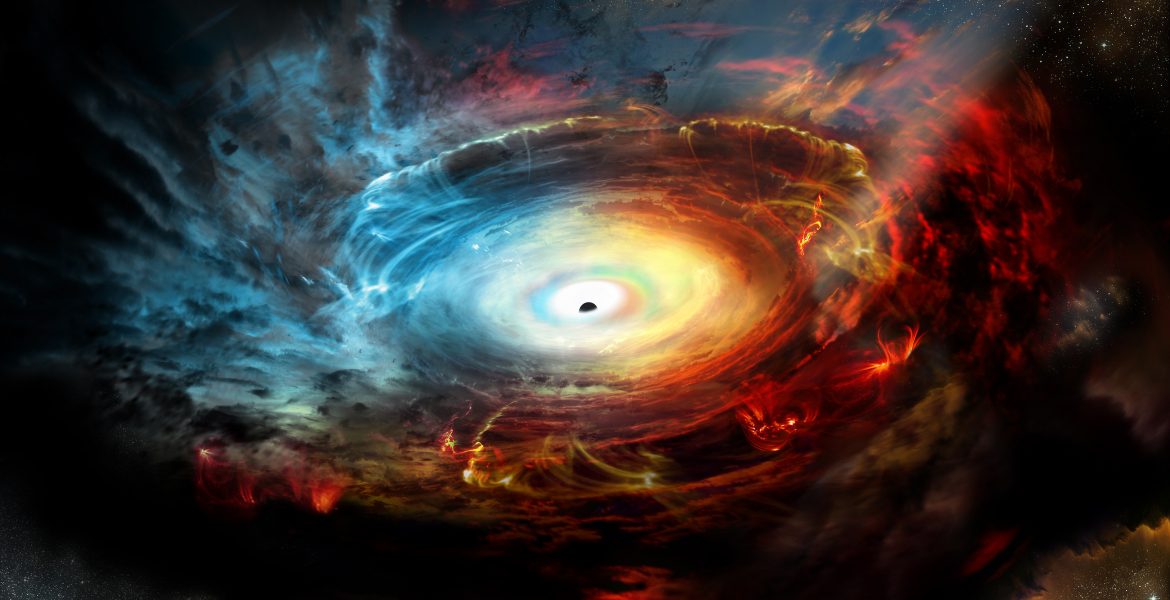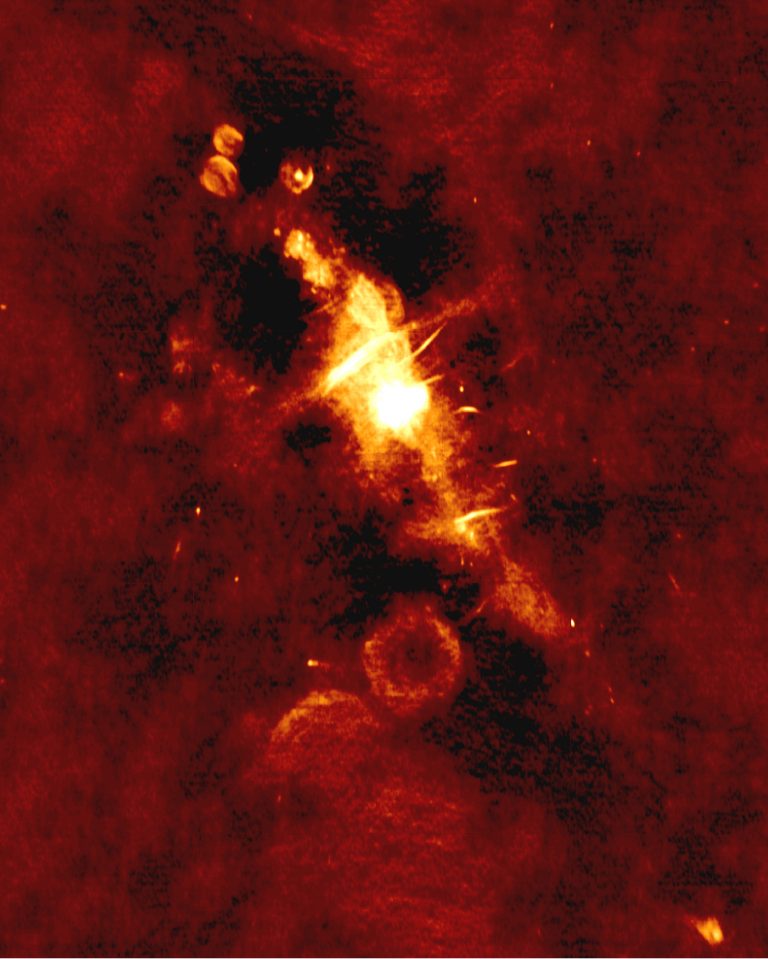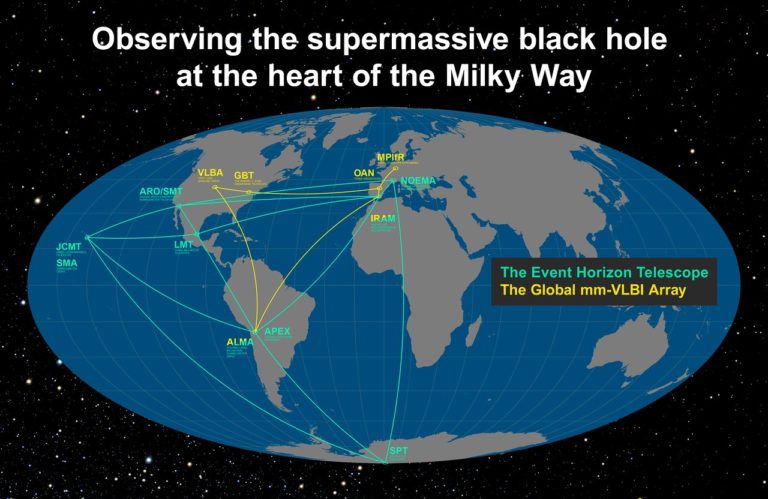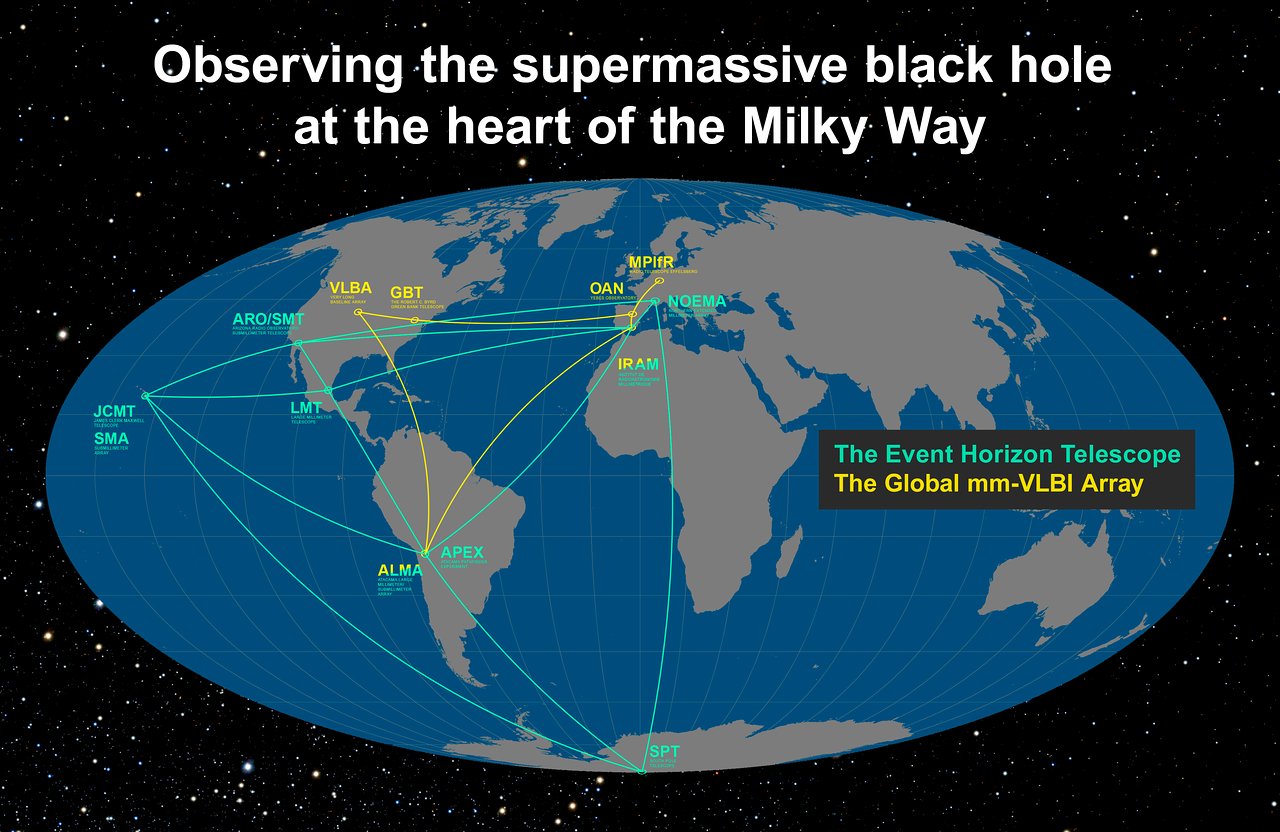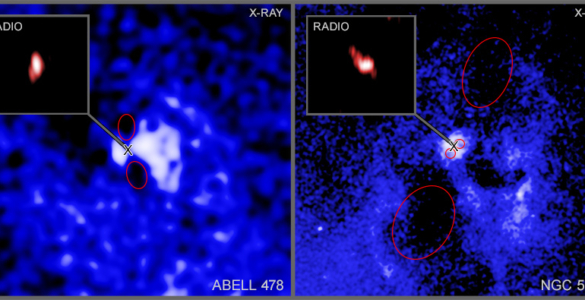Synopsis: Recently, a collection of radio observatories combined to form the GMVA, a powerful tool that probed the region near our galaxy’s supermassive black hole. This produced curious images of this region, glowing brightly in millimeter-wavelength radio light. These observations, which involved two U.S. radio telescopes – VLBA, and GBT – are an important step toward observing the event horizon of a supermassive black hole. Here is this story of this quest so far:
There is a giant in our backyard. We know it’s there, but no one has ever seen it. It’s a supermassive black holeSupermassive Black HoleA black hole that has a million or as much as a billion solar masses. These large black holes lurk at the centers of most galaxies., and it lurks in the center of our galaxy.
In 1931, engineer Karl Jansky first observed a strong cosmic radio signal emanating from the constellation Sagittarius, which lies in the direction to the center of our galaxy. Jansky assumed that the radio signals originated from the center of our galaxy, but he had no idea what that source could be and his telescope was incapable pinpointing the location of the exact source. That happened in 1974, when Bruce Balick and Robert Brown used three radio dishes at Green Bank Observatory and a fourth smaller dish about 35 km away to form a vastly more precise radio telescope called an interferometer.
An interferometerInterferometerA radio telescope consisting of two or more antennas at some distance from one another. It uses the phenomenon of interference, which combines the signals of each antenna that is part of the interferometer, to increase the effectiveness of the antennas’ ability to sharpen the details of an image taken of an object in the cosmos. is a way to use multiple radio telescopes or antennas as a single virtual telescope. When two antenna dishes are pointed at the same object in the sky they receive the same signal, but the signals are out of sync because it takes a bit longer to reach one antenna than the other. The time difference depends upon the direction of the antennas and their spacing apart from each other. By correlating the two signals you can determine the location of the source very precisely. With the Green Bank Interferometer, Balick and Brown confirmed the radio source as a small region near the galactic center. Brown later named the source Sagittarius A*Sagittarius A*A supermassive black hole that is located at the center of the Milky Way Galaxy. This powerful radio source lies just 26,000 light years from Earth and was discovered in 1974 by Bruce Balick and Robert L. Brown at Green Bank Observatory. (See supermassive black holes for more), or Sgr A* for short.
The Green Bank Interferometer was a precursor to NRAO’s Very Large ArrayVery Large ArrayThe Very Large Array is a customizable interferometer that varies between 2/3 of a mile to 22 miles long depending on the time of year. It is considered to be one of the most advanced radio telescope arrays on Earth with 28 antennas in Socorro, New Mexico. (VLA). The VLA has an array of 28 antennas capable of both widely separated and closely spaced configurations, making it the perfect tool for studying Sgr A*. In 1983, a team led by Ron Ekers used the VLA to make the first radio image of the Galactic Center, which revealed a mini-spiral of hot gas. Later observations showed not only the spiral of gas, but also a distinct and bright radio source at the exact center of the Milky Way.
By this time it was strongly suspected that this radio source was a massive black hole. From 1982 to 1998, Don Backer and Dick Sramek at the VLA measured the position of Sgr A* and found that it had almost no apparent motion. This meant it must be extremely massive since the gravitational tugs of nearby stars weren’t moving it about. They estimated it must have a mass at least two million times larger than the Sun. Long-term observations of stars orbiting the Galactic CenterGalactic CenterThe central region of a galaxy characterized by high densities of stars. The center might contain a supermassive black hole. In the case of the Milky Way, there is a supermassive black hole at the center of the galaxy called Sagittarius A*. have found Sgr A* to be about 3.6 million solar masses, and precise radio imaging has confirmed it can be no larger than the orbit of Mercury. We now know it is indeed a supermassive black hole.
Knowing a black hole is there isn’t the same as seeing it directly. Astronomers have long dreamed of directly observing a black hole, and perhaps even glimpsing its event horizonEvent HorizonThe boundary surface of a black hole where nothing can escape, not even light. . Sagittarius A* is the closest supermassive black hole to Earth, so there have been various efforts to observe it directly. But there are two big challenges to be overcome. The first is that the center of our galaxy is surrounded by dense gas and dust. Almost all the visible light from the region is obscured, so we can’t observe the black hole with an optical telescope. Fortunately, the gas and dust are relatively transparent to radio light, so radio telescopes can see to the heart of our galaxy. But this leads to the second major challenge: resolutionResolutionThe ability of a telescope to show detail. One common way to describe the resolution of a telescope is to state the minimum angular separation at which a double star can be distinguished as two separate stars. (see double star for more).
Although the Sgr A* black hole is massive, it is only about the size of a large star. According to Einstein’s theory of general relativity, a black hole of 3.6 million solar masses would have an event horizon only 15 times wider than the Sun. Since the Galactic Center is about 26,000 light years away from Earth, the black hole appears very small in the sky, about the same apparent size as a baseball sitting on the surface of the Moon. To see a radio object that small, you’d need a telescope the size of Earth itself.
Obviously, we can’t build a radio telescope the size of our planet, but with radio interferometry we can build a virtual Earth-sized telescope. NRAO observatories are currently working with two projects trying to observe a black hole, the Event Horizon Telescope (EHT) and the Global mm-VLBI Array (GMVA). The Atacama Large Millimeter/submillimeter Array (ALMA)Atacama Large Millimeter/submillimeter Array (ALMA)Funded by the U.S. National Science Foundation and its international partners (NRAO/ESO/NAOJ), ALMA is among the most complex and powerful astronomical observatories on Earth or in space. The telescope is an array of 66 high-precision dish antennas in northern Chile. is participating in both projects, while the Green Bank Telescope (GBT) and the Very Long Baseline Array (VLBA)Very Long Baseline Array (VLBA)An array of 10, 25 meter radio telescopes that stretches 8000km (5,000 miles) across North America. are part of GMVA. Just like the Very Large Array, these projects combine signals from multiple antennas. Since the antennas are located all over the world, this virtual telescope is about the size of the Earth. But unlike the VLA antennas, they all have different sizes and sensitivities. This diversity of antennas makes it more difficult to combine signals, but it also gives the projects a big advantage.
In the VLA, for example, all the antennas of the array are identical. Each antenna contributes equally, and the sensitivity of the array depends upon the size of a single antenna. But when telescopes, or antennas of different sizes, are combined, the sensitivity of the larger antennas helps boost the sensitivity of the smaller ones. The Green Bank Telescope, for example, has a diameter of 100 meters. When combined with smaller telescopes in a large interferometer, the total sensitivity depends upon the average size of all the antennas. This makes the ALMA array — connected to the EHT and the GMVA — and the GBT — linked to the GMVA — much more sensitive to signals from the Milky Way’s black hole, and we’ll need all the sensitivity we can get to capture the image of a black hole.
In January of 2019, GMVA captured an image of Sagittarius A* at 3mm wavelengths, but the scattering of 3mm light by the plasma between us and Sgr A* made it impossible to see the shadow of its event horizon. The first clear image of a black hole was announced by the Event Horizon Telescope in April 2019. It was an image of the black hole in the galaxy M87. While M87 is more than 2,000 times more distant than the black hole in the center of our galaxy, its black hole is also 1,500 times more massive. It’s a very active black hole, and not obscured by the gas and dust in our galaxy, making it easier to observe. Observing our smaller, quieter black hole is a bigger challenge. But by working with observatories all over the world, ALMA and the GBT will soon catch the first clear glimpse of the giant in our backyard.
Contact:
Brian Koberlein
bkoberle@nrao.edu


